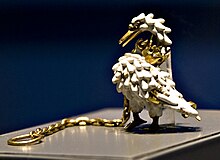
In post-classical history, an affinity was a collective name for the group (retinue) of (usually) men whom a lord gathered around himself in his service; it has been described by one modern historian as "the servants, retainers, and other followers of a lord",[1] and as "part of the normal fabric of society".[2] It is considered a fundamental aspect of bastard feudalism,[3] and acted as a means of tying magnates to the lower nobility, just as feudalism had done in a different way.[4]
One form of the relationship was known as livery and maintenance. The lord provided livery badges to be worn by the retainer and "maintenance" or his support in their disputes, which often constituted obstruction of judicial processes.
- ^ K. Kennedy (2009). Maintenance, Meed, and Marriage in Medieval English Literature. Springer. pp. 7–. ISBN 978-0-230-62162-6.
- ^ Holmes, G.A., The Later Middle Ages, 1272–1485 (Edinburgh, 1962), 167.
- ^ Ronald H. Fritze; William Baxter Robison (2002). Historical Dictionary of Late Medieval England, 1272–1485. Greenwood Publishing Group. pp. 3–. ISBN 978-0-313-29124-1.
- ^ Carpenter, C., 'The Beauchamp Affinity: A Study of Bastard Feudalism at Work', EHR 95 (1980), 514.
© MMXXIII Rich X Search. We shall prevail. All rights reserved. Rich X Search
